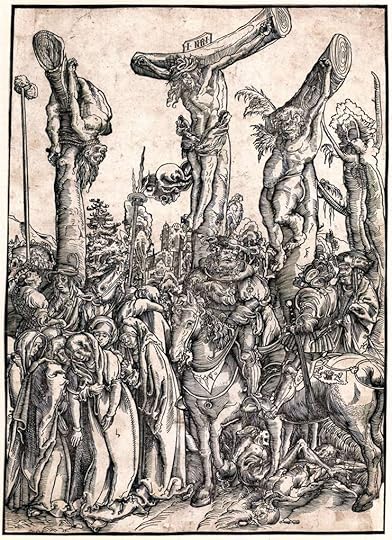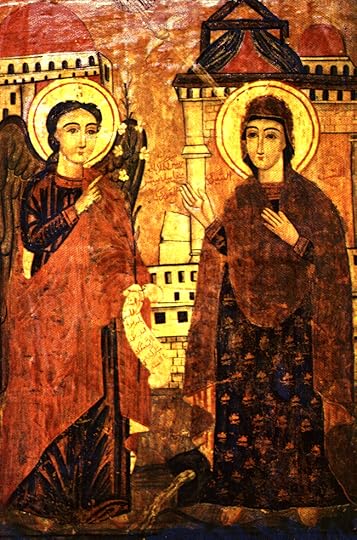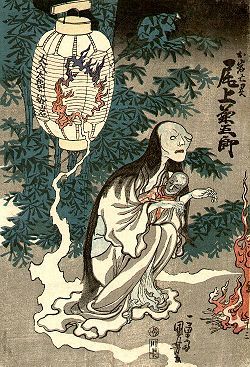Stephen Morris's Blog, page 28
April 1, 2018
Easter Monday

Easter Monday is a holiday in most of Europe. Offices and banks are closed. People get a 4-day weekend as most places were closed on Good Friday as well. I always thought it was a shame that the United States doesn’t get Easter Monday as a holiday as well.
The post Easter Monday appeared first on Stephen Morris, author.
March 26, 2018
Holy Week 2018

A detail showing Christ and the two theives on their crosses from “The Crucifixion” by Cranach the Elder (woodcut from approx. 1500-1504)
Holy Week, the days between Palm Sunday and Easter, is one of the most important and busiest times of the year in traditional European societies. Everyone is busy baking and cleaning and preparing for the great festival. There are many church services, especially at the end of the week on Thursday, Friday, and Saturday.
One of the more fascinating or frightening folktales of Holy Week tells us that in Prague and the Czech countryside, underground vaults, caves, and holes that contain hidden treasure will open up shine with a faint light as the Passion is chanted in church. A treasure-seeker can go outside church then and see these places and mark them to come back later. Or, if the treasure-seeker can’t wait to get rich, he can go inside the caves right then but he must get out before the last verse of the Passion reading is complete as the vault or cave will shut when the reading is complete and the treasure-seeker will be trapped inside until the next year.
In Russia, the tale is told that anyone who dies on Good Friday will be ushered directly into heaven just as the Good Thief was. (Many artists who painted depictions of the two thieves actually used the bodies of criminals who had been executed on the wheel as their models as no one was crucified any more; if you look closely, you can still see the thieves’ limbs twisted and bent in strange ways that don’t match descriptions of crucifixions because of their torture on the wheel.)
Much of the folklore associated with Holy Week involves protection of various sorts: To protect against the evil eye, wax from candles burned in church during the Holy Week services would be stuck to the heads of children or animals. Hanging a wreath on the door after sunset on Good Friday will protect the house against lightning. Hot cross buns baked on Good Friday and hung in the kitchen will protect against poverty and if they are hug over the bed, will protect against nightmares.
The post Holy Week 2018 appeared first on Stephen Morris, author.
March 19, 2018
“Happy New Year?!” Lady Day 2018

A Coptic icon of the Annunciation, showing the angel Gabriel presenting a lily as he announces the Incarnation to the Mother of God.
Lilies are often associated with the celebration of Annunciation. When Eve was driven from Paradise, lilies bloomed wherever her tears fell onto the earth and Gabriel presented lilies to the Virgin Mary when he announced that her Son would re-open Paradise to mankind. Other legends say that lilies blossomed from drops of milk from Hera’s breasts that fell upon the earth and that the lily was therefore the only flower with a soul. Lilies are traditionally considered to drive away ghosts and evil (esp. the Evil Eye) and can break love spells. The first lily of the season strengthens whoever finds it.
Roses are also associated with Annunciation and are used to cast love spells or in healing magic. If you plant roses in your garden, they are said to grow best if you have stolen the seeds from someone else and will then attract the faerie folk.
The Annunciation is celebrated on March 25 (the traditional date of the springtime equinox). Not only was Annunciation — and the equinox — vital to keeping track of time for secular purposes, many ancient and medieval authors claimed that the Annunciation/equinox date were vital at many points of salvation history: the birthday of Adam and the Crucifixion were said to have occurred on March 25 as well. Some also said that March 25 marked the fall of Lucifer, the parting of the Red Sea, as well as the day on which God said, “Let there be light!”
Sometimes called “Lady Day,” the Annunciation was kept as New Year’s Day in many places; the last to give up Annunciation as the New Year’s Day was England and its American colonies in 1752. The correct synchronization of the equinox with the Annunciation is a critical element in the calculation of the date of Easter and the medieval and Renaissance disconnect between the Annunciation and the equinox prompted Pope Gregory XIII to reform the calendar in 1582.
The post “Happy New Year?!” Lady Day 2018 appeared first on Stephen Morris, author.
March 9, 2018
“Beware the Ides of March, 2018!”
Vincenzo Camuccini, “Morte di Cesare”, 1798,
“Beware the ides of March!” the prophet warned Julius Caesar in 44 B.C. and Caesar was assassinated shortly thereafter, on the ides. Ever since, the Ides of March has been a day associated with doom, disaster, or failure in some form. But what is the “ides”?
Unlike currently used dates, which are numbered sequentially from the beginning of the month, the Romans and medieval Europeans counted backwards from three fixed points: they designated the “kalends,” the “nones,” and the “ides” and all other dates were based on these. (ex. the kalends = the 1st, the nones = the 5-7th, and the ides = the 13-15th days of the month). For instance, rather than saying, “Today is March 3” they would say, “Today is three days before the nones of March.” The kalends marked the new moon, the nones was the half-moon and the ides was the full moon.
The ides of the month marked the full moon and thus the following days of each month were governed by the waning moon, a good time for curses as dark magic grew more powerful as the nights grew darker. Not only would dark magic grow stronger but the darker nights also made crime in general more likely. That the last half of each month was steeped in evil and disaster was underscored by its association with the assassination of Caesar.
The post “Beware the Ides of March, 2018!” appeared first on Stephen Morris, author.
March 2, 2018
Pietà

A German depiction of the Pietà, c. 1375–1400
Renaissance genius Michelangelo (1475-1564) was born on March 6 in Caprese, Italy. He was a painter, sculptor, architect, poet and visionary best known for his fresco on the ceiling of the Sistine Chapel and his sculptures David and The Pieta.
The Pietà (“pity”) was an image designed to provoke pity and charity among the viewers. The Virgin Mary holds the dead body of her son, Jesus, on her lap. She is often identified as an altar in these images, especially the ones in which her knees are spread wide to support the body of Christ stretched out across them, because her lap–draped with her gown and veil–looks similar to the rectangular altars in medieval and Renaissance churches which were also draped with brocade during the celebration of the Eucharist. The offerings viewers make in response to the image–food for the hungry, clothes for the naked, medicine for the sick–are identified with the offering of the Virgin’s son on the Cross and on the altars.
In some places, gifts of wheat were made to churches in honor of the Pietà image. The wheat would be used to make bread for the poor as well as bread for the Eucharist. Jesus, a dead body but identified as the Bread of Life on the lap of his Mother, is awaiting the Resurrection. The viewers who make these gifts of wheat are likewise awaiting their own opportunity to share the Resurrection and hope that their gifts will move Christ to judge them mercifully, with pity.
Festivals in honor of the Pietà image grew in popularity in the 12th century in German-speaking areas. One was especially popular in Cologne in 1423 and was held on the Friday after the third Sunday after Easter. During the sixteenth century these festivals spread through areas in North Germany, Scandinavia, and Scotland. By the early 1700s, the Pietà festival was common throughout Western Europe.
The post Pietà appeared first on Stephen Morris, author.
February 23, 2018
Rabbit! Rabbit!

A European rabbit. A new report debunked the long-held scientific tale that rabbits were domesticated in 600 A.D. because a pope declared their fetal meat to be like fish and therefore O.K. to eat during Lent.
Credit
APCOR/DKV
According to longstanding folklore, Pope Gregory the Great gave monks in France permission to consider rabbits-in-utero to be “fish” rather than meat and so elgible to be eaten during Lent. What apparently really happened was that a different Gregory, St. Gregory of Tours, simply described how someone he knew ate rabbit during Lent. But the story got slightly jumbled and the jumbled version lasted for hundreds of years. You can read about what happened here.
Rabbits are featured in folklore around the world. Although the English-speaking world is familiar with the man-in-the-moon, in Asia and among the Aztecs it is a rabbit-in-the-moon who looks down at the earth from the night sky. The rabbit-in-the-moon is there as a reward for an act of charity to a hungry old man. According to the story, a monkey, an otter, a jackal, and a rabbit resolved to practice charity on the day of the full moon, believing a demonstration of great virtue would earn a great reward. When an old man begged for food, the monkey gathered fruits from the trees and the otter collected fish, while the jackal wrongfully pilfered a lizard and a pot of milk-curd. The rabbit, who knew only how to gather grass, instead offered its own body, throwing itself into a fire the man had built. The rabbit, however, was not burnt but rose to the sky with the smoke from the fire. The likeness of the rabbit is still there on the moon for all to see.
In many places, rabbits were symbols of women, femininity, female deities, and female magic which was associated with the lunar cycle, fertility, longevity, and rebirth. Rabbits are also contradictory, paradoxical creatures: symbols of both cleverness and foolishness, of femininity and androgyny, of cowardice and courage, of rampant sexuality and virginal purity. In some lands, Hare is the messenger of the Great Goddess, moving by moonlight between the human world and the realm of the gods; in other lands he is a god himself, wily deceiver and sacred world creator rolled into one.
The post Rabbit! Rabbit! appeared first on Stephen Morris, author.
February 16, 2018
Japanese Folklore

Oiwa was a woman given poison by her unfaithful husband. It disfigured her but did not kill her. She prayed to become a demon to kill her husband, his new girlfriend, and their families.
February 11, 660 BC is celebrated as the birthday of Japan as the first emperor, Jimmu, was enthroned on that day. Less gloriously, February 19, 1942 marked the beginning of the internment of Japanese Americans during World War II in the United States. Over 110,000 people living along the Pacific coast lost their businesses and property when they were moved to “relocation centers” inland.
Japan is the home of tremendous folklore and mythology, much of it unknown to Americans or Western Europeans. Japanese mythology is a complex system of beliefs that also embraces Shinto and Buddhist traditions as well as agriculture-based folk religion. Oni (demons) and yurei (ghosts) have played a role in Japanese culture for thousands of years, and stories of new spirits continue to be told today. Many stories are about hannya, which in Noh theater are women whose rage and jealousy turned them into oni while still alive.
One story about such a woman tells how Kiyohime was a young woman scorned by her lover, a monk named Anchin, who grew cold and lost interest in her. Realizing he had left her, Kiyohime followed him to a river and transformed into a serpent while swimming after his boat. Terrified by her monstrous form, Anchin sought refuge in a temple, where monks hid him beneath a bell. Not to be evaded, Kiyohime found him by his scent, coiled around the bell, and banged loudly on it with her tail. She then breathed fire onto the bell, melting it and killing Anchin.
Yuki Onna is a terrible ghost who haunts the snowy forests looking for victims. She is a kind of ghost-vampire who lives by sucking the vital energy of the human body. She extracts the soul by first freezing her victims to death, then sucking their souls out through their mouths. Some stories about Yuki Onna say that she particularly prefers the souls of children.
Click here or here to read more about Japanese folklore.
The post Japanese Folklore appeared first on Stephen Morris, author.
February 9, 2018
Mary, Queen of Scots

Kelpie, or water kelpie, is the Scots name given to a shape-shifting water spirit inhabiting the lochs and pools of Scotland. It has usually been described as appearing as a horse, but is able to adopt human form.
Mary Stuart, commonly known as “Mary, Queen of Scots” was beheaded on February 8, 1587 at the order of her cousin Queen Elizabeth I of England. Mary (a Roman Catholic) had become caught up in complicated plots and counterplots surrounding Elizabeth, a Protestant queen, on the throne of England. Although Mary was kept a prisoner in England for 19 years and was finally beheaded for her role in a plot to have Elizabeth killed, Mary and Elizabeth never met. But the other great queens of the Scots were the goddesses known as the “hag”, the Cailleach, and the Giantess.
The folklore of Scotland is not nearly as well known as the folklore of Ireland or England, except perhaps for the monster said to live in Loch Ness. The first reported sighting of the Loch Ness Monster was in the River Ness in 565 AD. The Irish monk Saint Columba was staying in the land of the Picts with his companions when he came across the locals burying a man by the River Ness. They explained that the man had been swimming the river when he was attacked by a “water beast” that had mauled him and dragged him under. They tried to rescue him in a boat, but were able only to drag up his corpse. Hearing this, Columba stunned the Picts by sending his follower Luigne moccu Min to swim across the river. The beast came after him, but Columba made the sign of the cross and commanded: “Go no further. Do not touch the man. Go back at once.” The beast immediately halted as if it had been “pulled back with ropes” and fled in terror, and both Columba’s men and the pagan Picts praised God for the miracle. Many modern people think the monster is a lone survivor of the otherwise extinct plesiosaurs.
Brownies–not the youngest division of Girl Scouts!–are said to inhabit houses and aid in tasks around houses in Scotland, like getting rid of spiders. However, they do not like to be seen and will only work at night, traditionally in exchange for small gifts of food. Among food, they especially enjoy porridge, honey, butter, and cream. They usually abandon the house if their gifts are called payments, or if the owners of the house misuse them. Brownies make their homes in an unused part of the house, often in attics and holes in walls.
You can read more about Scottish mythology here. Or find lots of fairy tales from Scotland here.
The post Mary, Queen of Scots appeared first on Stephen Morris, author.
February 2, 2018
Spring is Sprung!

Snowdrops at a creek announce Imbolc. The first blooms of snowdrops or blackthorns or the first birth of the new lambs were often considered the announcement of Imbolc’s arrival. (photo by Tony Eaglehart)
The Celtic — and magical! — festival of Imbolc, celebrated February 1-2, was considered the first day of spring in Celtic cultures and across Europe in general during the medieval period. Although we nowadays generally consider the solstice or equinox the first day of a season (December 21 as the first day of winter, March 21 as the first day of spring, June 21 as the first day of summer, and September 21 as the beginning of autumn), those days were previously considered the mid-seasons. (That is why we can sing Christmas carols about “midwinter” in December and have Midsummer night dreams in June!) The traditional changes of the seasons were the “quarter days” which marked the midpoints between the mid-seasons. So we get the Celtic/magical festivals of Samhain (October 31, the first day of winter), Imbolc (February 1-2, the beginning of spring), Beltane (May, the first day of summer), and Lammas (August 1, the beginning of autumn).
Because Imbolc is the beginning of spring, it is often associated with various means of predicting the coming weather which is so crucial during the planting season of agricultural societies. Hence, we consult the groundhog to determine if he sees his shadow or not in order to know if cold and snow will last another six weeks or not. In Serbia, a bear who wakes from his hibernation to stumble out of his cave and see his shadow will know whether to go back to sleep for another six weeks or not, based on whether he sees his shadow. Imbolc was believed to be when the Cailleach—the divine hag of Gaelic tradition—gathers her firewood for the rest of the winter. Legend has it that if she wishes to make the winter last a good while longer, she will make sure the weather on Imbolc is bright and sunny, so she can gather plenty of firewood. Therefore, people would be relieved if Imbolc is a day of foul weather, as it means the Cailleach is asleep and winter is almost over. At Imbolc on the Isle of Man, where she is known as Caillagh ny Groamagh, the Cailleach is said to take the form of a gigantic bird carrying sticks in her beak.
The post Spring is Sprung! appeared first on Stephen Morris, author.
January 26, 2018
Happy birthday to Wolfgang and Charles!

I got these Christmas tree decorations–the Red Queen, the Cheshire cat, and the White Rabbit–at the Alice in Wonderland shop in Oxford.
Happy birthday! Wolfgang Amadeus Mozart was born in Salzburg on January 27,1756 and Charles Lutwidge Dodgson (later known as “Lewis Carroll”) was born in Cheshire, England on January 27, 1832. Both created famous female characters steeped in mystery and magic.
Mozart’s opera The Magic Flute features the Queen of the Night. She is first introduced as the desperate mother whose beloved daughter was kidnapped. But it ultimately appears that she is the villain of the story, who wants to steal the powerful Circle of the Sun. In many ways the Queen of the Night can be regarded as an early symbol of a free woman, given that she claims something which she regards as her legitimate heirloom, but whose property she was denied because she is a woman. She strongly resents this, and is willing to defy the patriarchal order who denies her all authority by any mean she can. She can also be regarded as a symbol of ignorance, either one who covets the Enlightenment she was denied or one who wants to destroy said Enlightenment out of intolerance.
When Dodgson was a professor at Oxford, he created the Alice in Wonderland character. She is also a free woman who sets out on her own to explore the strange alternate universe known as “Wonderland.” Both Alice and the Queen of the Night seem to depend on magic–Alice needed the bottle marked “Drink me” as well as the cookie marked “Eat me” and the Queen’s power and position is threatened by the sorcerer Sarastro–but neither seem to be completely in control of the magic they depend on.
When I’ve been to Oxford, I have seen many of the places that also appear in the Alice stories, such as the tree that the Cheshire cat sat in and the small door known as the “rabbit hole” in the dining hall. There is a small store there that features nothing but Alice-related items.
You can see great spoofs of the famous Queen of the Night aria here and here. Enjoy!
The post Happy birthday to Wolfgang and Charles! appeared first on Stephen Morris, author.



